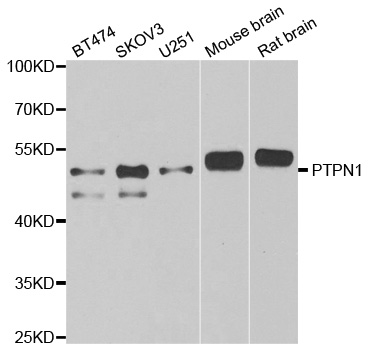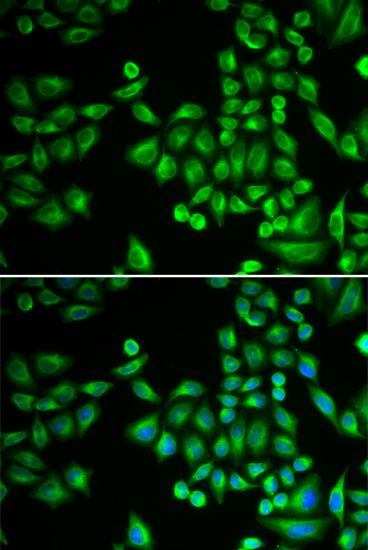Product Name :
PTPN1 polyclonal antibody Background :
The phosphorylation of proteins at tyrosine residues has long been recognized as an important regulatory component of signal transduction. This is areversible process, involving both enzymes that phosphorylate proteins ontyrosine residues as well as a rapidly expanding family of protein tyrosinephosphatases. These latter enzymes bear little resemblance to either theprotein serine and protein threonine phosphatases or to the acid and alkalinephosphatases. In most tissues, the major PTPase is a vanadate- and molybdate-sensitive protein of approximately 40 kDa molecular weight. On the basis of sequence analysis, PTP1B expressed in human placenta exhibits similarities both with the common leukocyte antigen (CD45) and with LAR, ahomolog of the neural adhesion molecule (NCAM). PTPase 1B is synthesized as a 435 amino acid precursor protein which is cleaved to generate the active 321 amino acid enzyme. Product :
Rabbit IgG, 1mg/ml in PBS with 0.02% sodium azide, 50% glycerol, pH7.2 Storage&Stability :
Store at 4°C short term. Aliquot and store at -20°C long term. Avoid freeze-thaw cycles. Specificity :
PTPN1 polyclonal antibody detects endogenous levels of PTPN1 protein. Immunogen :
Recombinant full length Human PTPN1. Conjugate :
Unconjugated Modification :
Unmodification
PTPN1 polyclonal antibody Background :
The phosphorylation of proteins at tyrosine residues has long been recognized as an important regulatory component of signal transduction. This is areversible process, involving both enzymes that phosphorylate proteins ontyrosine residues as well as a rapidly expanding family of protein tyrosinephosphatases. These latter enzymes bear little resemblance to either theprotein serine and protein threonine phosphatases or to the acid and alkalinephosphatases. In most tissues, the major PTPase is a vanadate- and molybdate-sensitive protein of approximately 40 kDa molecular weight. On the basis of sequence analysis, PTP1B expressed in human placenta exhibits similarities both with the common leukocyte antigen (CD45) and with LAR, ahomolog of the neural adhesion molecule (NCAM). PTPase 1B is synthesized as a 435 amino acid precursor protein which is cleaved to generate the active 321 amino acid enzyme. Product :
Rabbit IgG, 1mg/ml in PBS with 0.02% sodium azide, 50% glycerol, pH7.2 Storage&Stability :
Store at 4°C short term. Aliquot and store at -20°C long term. Avoid freeze-thaw cycles. Specificity :
PTPN1 polyclonal antibody detects endogenous levels of PTPN1 protein. Immunogen :
Recombinant full length Human PTPN1. Conjugate :
Unconjugated Modification :
Unmodification
-
 Western blot analysis of extracts of various cell lines, using PTPN1 antibody.
Western blot analysis of extracts of various cell lines, using PTPN1 antibody. -
 Immunofluorescence analysis of MCF-7 cell using PTPN1 antibody. Blue: DAPI for nuclear staining.
Immunofluorescence analysis of MCF-7 cell using PTPN1 antibody. Blue: DAPI for nuclear staining.
Bioworld Biotech only provide peptides for our antibodies and do not provide additional peptide customization services.
Price/Size :
USD 368/1mg/vial
Tips:
For phospho antibody, we provide phospho peptide(0.5mg) and non-phospho peptide(0.5mg).Describe :
Blocking peptides are peptides that bind specifically to the target antibody and block antibody binding. These peptide usually contains the epitope recognized by the antibody. Antibodies bound to the blocking peptide no longer bind to the epitope on the target protein. This mechanism is useful when non-specific binding is an issue, for example, in Western blotting (WB) and Immunohistochemistry (IHC). By comparing the staining from the blocked antibody versus the antibody alone, one can see which staining is specific; Specific binding will be absent from the western blot or IHC performed with the neutralized antibody.Formula:
Synthetic peptide was lyophilized with 100% acetonitrile and is supplied as a powder. Reconstitute with 0.1 ml DI water for a final concentration of 10 mg/ml.The purity is >90%,tested by HPLC and MS.
Storage:
The freeze-dried powder is more stable. For short time at 2-8°C. For long term storage store at -20°C.
Note :
This product is for research use only (RUO only). Not for use in diagnostic or therapeutic procedures.
 PTPN1 polyclonal antibody
PTPN1 polyclonal antibody  Datasheet
Datasheet COA
COA MSDS
MSDS SHIP
SHIP